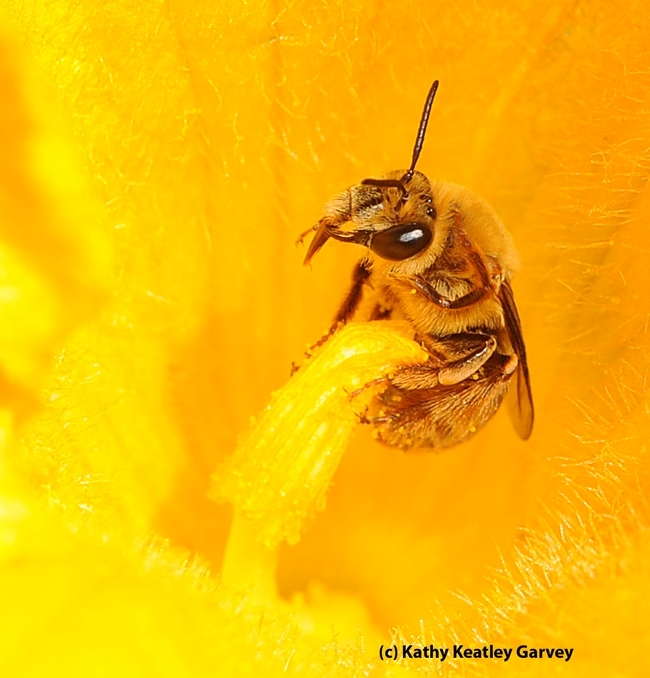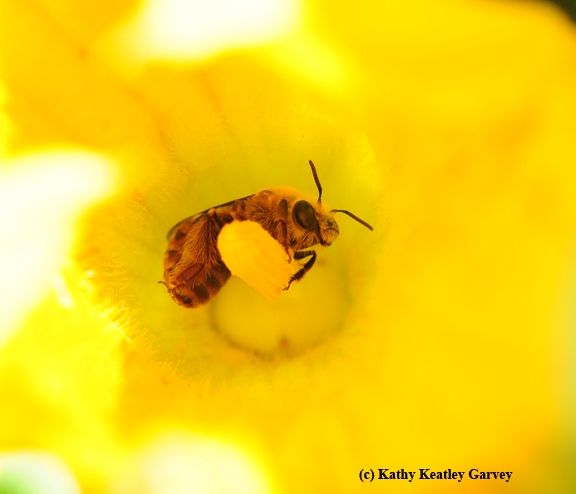
Posts Tagged: squash bee
Happy National Squash Bee Day!
In case you missed it, today was National Pumpkin Day. But it ought to be National Squash Bee Day,...

Squash bee, Peponapis pruinosa, inside a squash blossom. (Photo by Kathy Keatley Garvey)
Why the Squash Bee Is Important
Peponapis pruinosa isn't your common household word. But among the people who study...

Squash bee, Peponapis pruinosa, on a squash blossom. (Photo by Kathy Keatley Garvey)

The squash bee, Peponapis pruinosa, is a specialist, pollinating only the Cucurbita genus. (Photo by Kathy Keatley Garvey)
All About Pollination
Pollination--what should we know? How can we attract pollinators to our gardens and agricultural...

Squash bee, Peponapis pruinosa. (Photo by Kathy Keatley Garvey)

Leafcutting bee, Megachile fidelis, on Mexican sunflower, Tithonia. (Photo by Kathy Keatley Garvey)

Sunflower bee, Svastra obliqua expurgata. (Photo by Kathy Keatley Garvey)
Just bee-cause
It's National Pollinator Week. Have you hugged your pollinators today, particularly the bees?
If you don't pay attention to the bees around you, you may think that every floral visitor is a honey bee (Apis mellifera) or a bumble bee (Bombus).
Not!
If you look closely, you'll see bee diversity: leafcutter bees, green metallic sweat bees, cuckoo bees, long-horned bees, carpenter bees, and squash bees, just to name a few.
Native pollinator specialist Robbin Thorp, UC Davis emeritus professor of entomology, has detected 80 different species of bees - and counting - in the Häagen-Dazs Honey Bee Haven on Bee Biology Road at UC Davis. The half-acre garden, planted in the fall of 2009, is located next to the Harry H. Laidlaw Jr. Honey Bee Research Facility. It's intended to be a year-around food source for the Laidlaw bees and other pollinators, to raise public awareness about the plight of bees, and to demonstrate what you can plant in your own garden.
"Of about 4,000 bee species known in the entire United States, about 1,600 have been recorded in California," according to Gordon Frankie of UC Berkeley, Robbin Thorp and their colleagues, in a must-read article in California Agriculture.
They point out: "...many types of urban residential gardens provide floral and nesting resources for the reproduction and survival of bees, especially a diversity of native bees. Habitat gardening for bees, using targeted ornamental plants, can predictably increase bee diversity and abundance, and provide clear pollination benefits."
Be sure to check out UC Berkeley's Urban Bee Gardens website that's described as "a practical guide to introducing the world’s most prolific pollinators into your garden." It's an educational treasure.
Bottom line: It's good to bee-aware, especially when research studies show that our pollinator population is declining worldwide.

A male cuckoo bee, Triepeolus concavus, the cuckoo that is a cleptoparasite on Svastra, according to Robbin Thorp. (Photo by Kathy Keatley Garvey)

Female metallic green sweat bee, Agapostemon texanus. (Photo by Kathy Keatley Garvey)

A male leafcutting bee, Megachile sp., on rock purslane. (Photo by Kathy Keatley Garvey)

A male long-horned bee, Melissodes communis, on salvia. (Photo by Kathy Keatley Garvey)

A male Valley carpenter bee, Xylocopa varipuncta. (Photo by Kathy Keatley Garvey)

Male squash bee, Peponapis pruinosa. (Photo by Kathy Keatley Garvey)
Thanks Be to the Squash Bee
If you’re having pumpkin muffins, pumpkin pancakes and pumpkin pie today (Thanksgiving), you...

Squash bee inside pumpkin blossom. (Photo by Kathy Keatley Garvey)

Close-up of the tiny squash bee, genus Peponapis. (Photo by Kathy Keatley Garvey)

These are the work of a squash bee: from left, a large gourd, a small pumpkin and a large pumpkin. (Photo by Kathy Keatley Garvey)
